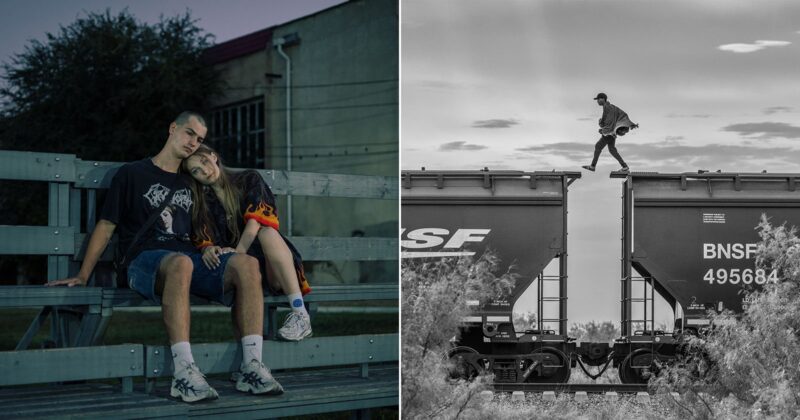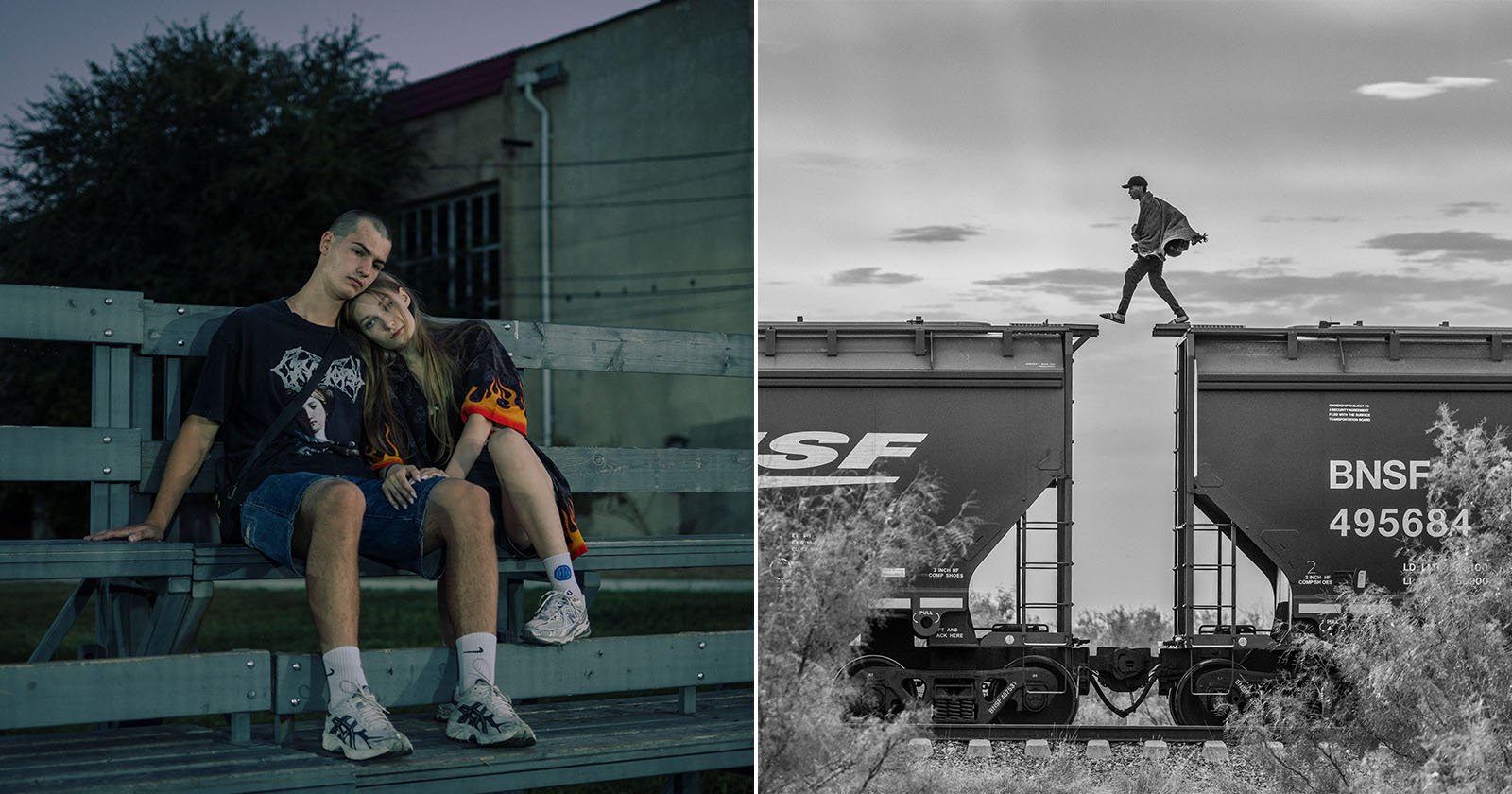
The winners of the 45th edition of the prestigious Leica Oskar Barnack Award are photographers Alejandro Cegarra and Serghei Duve. The two photographers prevailed over more than 300 others nominated by around 120 experts in nearly 50 countries.
Born in Venezuela but now based in Mexico, Cegarra won the main award for his series The Two Walls. Meanwhile, German photographer Serghei Duve’s series, Bright Memory, earned the photographer the LOBA Newcomer award.
Alejandro Cegarra: The Two Walls — 2025 Leica Oskar Barnack Award Winner
For his award-winning long-term project, The Two Walls, Cegarra traveled and worked in the borderlands between the United States and Mexico. The black-and-white photo series focuses on the challenges that migrants and refugees face in the region, and the exceptional dangers they incur in search of a better life.
![]() A migrant walks on top of a parked freight train known as ‘The Beast’ on the outskirts of Piedras Negras, Mexico 2023. From the series The Two Walls. | © Alejandro Cegarra/LOBA 2025
A migrant walks on top of a parked freight train known as ‘The Beast’ on the outskirts of Piedras Negras, Mexico 2023. From the series The Two Walls. | © Alejandro Cegarra/LOBA 2025 ![]() Eddie, Carolina and their four-year-old daughter Valentina, hide inside of an abandoned house before reaching the Rio Bravo in Piedras Negras, Mexico 2023. From the series The Two Walls. | © Alejandro Cegarra/LOBA 2025
Eddie, Carolina and their four-year-old daughter Valentina, hide inside of an abandoned house before reaching the Rio Bravo in Piedras Negras, Mexico 2023. From the series The Two Walls. | © Alejandro Cegarra/LOBA 2025
Mexico was once considered safe for refugees, but in recent years, the country has worked closely with anti-immigration efforts in the United States, which has made the country significantly more inhospitable for refugees.
Cegarra’s powerful photographs turn the lens toward these migrants and their families who face horrendous conditions at the Mexican-U.S. border.
![]() Eddie, Carolina and their four-year-old daughter Valentina, hide inside of an abandoned house before reaching the Rio Bravo in Piedras Negras, Mexico 2023. From the series The Two Walls. | © Alejandro Cegarra/LOBA 2025
Eddie, Carolina and their four-year-old daughter Valentina, hide inside of an abandoned house before reaching the Rio Bravo in Piedras Negras, Mexico 2023. From the series The Two Walls. | © Alejandro Cegarra/LOBA 2025 ![]() Asylum seekers wait at the gates of the Mexican Commission for Aid to Refugees (COMAR) for an asylum hearing. Tapachula, Mexico 2019. From the series The Two Walls. | © Alejandro Cegarra/LOBA 2025
Asylum seekers wait at the gates of the Mexican Commission for Aid to Refugees (COMAR) for an asylum hearing. Tapachula, Mexico 2019. From the series The Two Walls. | © Alejandro Cegarra/LOBA 2025
“I worked on this series from 2018 to January of this year and was always between the borders,” Alejandro Cegarra says. “I wanted to concentrate on the humanity and universally human emotions.”
The photographer took 35,000 images in total as part of his project, of which 20 were selected for the LOBA series.
![]() Ever Sosa carries his daughter on his shoulders as they cross the Suchiate River from Guatemala to Mexico, Mexico 2020. From the series The Two Walls. | © Alejandro Cegarra/LOBA 2025
Ever Sosa carries his daughter on his shoulders as they cross the Suchiate River from Guatemala to Mexico, Mexico 2020. From the series The Two Walls. | © Alejandro Cegarra/LOBA 2025
Cegarra, born in 1989, began his photographic career in 2012 when he began working for Venezuela’s largest newspaper, Últimas Noticias. Since then, he has worked as a freelance photographer and been published in major newspapers and magazines like National Geographic, The New Yorker, TIME, and more. He also received the Getty Editorial Grant in 2017, the same year he moved to Mexico, and the Global Award for Long-Term Projects from World Press Photo in 2019 and 2024.
![]() Portrait of Alejandro Cegarra | © Elsa Acare
Portrait of Alejandro Cegarra | © Elsa Acare
Notably, Cegarra also won the Leica Oskar Barnack Newcomer Award in 2014 for his series, The Other Side of the Tower of David, a photo series about squatters in an unfinished high-rise in Caracas, Venezuela.
This year, Cegarra was nominated for consideration by Colombian photographer Federico Rios Escobar.
Serghei Duve: Bright Memory — 2025 Leica Oskar Barnack Newcomer Award
Photographer Serghei Duve was born in 1999 in Chișinău, Moldova, but his parents took him and the rest of the family to Hanover, Germany, when Duve was just one. Although he grew up in Germany, his family’s Russian culture remained an essential part of his childhood, and they spoke Russian in the family home.
![]() Portrait of Serghei Duve | © Alexander Duve
Portrait of Serghei Duve | © Alexander Duve
At age 10, Duve received a camera for his birthday, which quickly turned into a passion. Duve has been studying in the Visual Journalism and Documentary Photography department at the Hanover University of Applied Sciences and Arts since 2021. His photographic work primarily centers around identity and origin, often relating directly to his own experiences and connections to his roots.
![]() Valera and Artjom argue about the war in Ukraine. Tiraspol, Transnistria, Republic of Moldova 2023. From the series Bright Memory. | © Serghei Duve/LOBA 2025
Valera and Artjom argue about the war in Ukraine. Tiraspol, Transnistria, Republic of Moldova 2023. From the series Bright Memory. | © Serghei Duve/LOBA 2025
![]() Valera on the sofa in his living room. Tiraspol, Transnistria, Republic of Moldova 2023. From the series Bright Memory. | © Serghei Duve/LOBA 2025
Valera on the sofa in his living room. Tiraspol, Transnistria, Republic of Moldova 2023. From the series Bright Memory. | © Serghei Duve/LOBA 2025
Bright Memory explores Duve’s family’s connections to Transnistria, a fascinating territory that declared its independence from Moldova in 1990. The region remains unrecognized internationally and is supported only by Russia.
Through his images, Duve seeks to visualize the sentiment that is captured by the Russian expression, “bright memory.” This term refers to how everyday life is shaped by nostalgia and division.
![]() Family shooting with an air rifle. Tiraspol, Transnistria, Republic of Moldova 2024. From the series Bright Memory. | © Serghei Duve/LOBA 2025
Family shooting with an air rifle. Tiraspol, Transnistria, Republic of Moldova 2024. From the series Bright Memory. | © Serghei Duve/LOBA 2025 ![]() Saying goodbye before the flight back to Germany. Tiraspol, Transnistria, Republic of Moldova 2024. From the series Bright Memory. | © Serghei Duve/LOBA 2025
Saying goodbye before the flight back to Germany. Tiraspol, Transnistria, Republic of Moldova 2024. From the series Bright Memory. | © Serghei Duve/LOBA 2025 ![]() Sasha and Kira on their last evening before he begins his military service. He would like to move to Europe. Tiraspol, Transnistria, Republic of Moldova 2023. From the series Bright Memory. | © Serghei Duve/LOBA 2025
Sasha and Kira on their last evening before he begins his military service. He would like to move to Europe. Tiraspol, Transnistria, Republic of Moldova 2023. From the series Bright Memory. | © Serghei Duve/LOBA 2025
The Leica Oskar Barnack Newcomer Award is available to young photographers up to the age of 30. Duve’s series was nominated by the Visual Journalism and Documentary Photography department at the Hochschule Hanover — University of Applied Sciences and Arts.
Cegarra and Duve Bested Very Talented Competition
“This year’s Leica Oskar Barnack Award jury reached their decision with close consideration and a deep appreciation for photography’s social impact,” says Karin Rehn-Kaufmann, Art Director and Chief Representative of Leica Galleries International.
“Alejandro Cegarra’s path is particularly moving: As a former winner of the Newcomer category, he returns with his impressive series The Two Walls, — a work which highlights the topics of division, migration, and human dignity with vivid imagery. His graduation from newcomer to the main category is a first in the history of the award and shows how photographic voices grow and are becoming more urgent than ever.”
Felix Hoffmann, Curator at Foto Arsenal Vienna adds: “The LOBA has established itself as a key reference point for the international photography scene, embodying quality, diversity, and social relevance. The wide range of topics was striking this year: from very personal stories to global social issues.”
This year marks the 100th anniversary of the Leica I, the first mass-produced 35mm camera. So this 45th edition of the Leica Oskar Barnack Award coincides with Leica’s expansive “100 Years of Leica: Witness to a Century” celebration.
The Leica Oskar Barnack Award is among the most renowned photography competitions in the world. Consequently, both Cegarra and Duve received a significant prize in addition to the immense honor. Cegarra has earned a 40,000 euro cash prize and a Leica camera kit worth 10,000 euros for winning the main award. Meanwhile, Duve’s Newcomer Award comes with 10,000 euros and a Leica Q3.
All of the LOBA series are now on exhibit at the Ernst Leitz Museum Wetzlar with support from WhiteWall. Following the show in Wetzlar, the winning photos will go on tour at various Leica Galleries and photography festivals worldwide.
Leica Oskar Barnack Award, Alejandro Cegarra, and Serghei Duve
